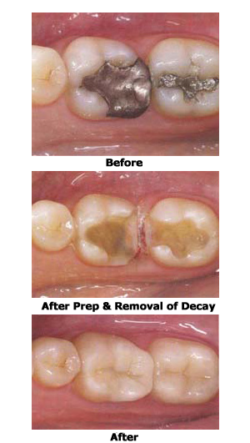What are onlays?
 An onlay is a covering that encases part(s) of a tooth surface(s) restoring it to its original shape and size; this restoration protects and strengthens tooth structure. An onlay is diagnosed, when a tooth is too far broken down to be restored by a filling and yet not broken down far enough to be restored by a crown (cap).
An onlay is a covering that encases part(s) of a tooth surface(s) restoring it to its original shape and size; this restoration protects and strengthens tooth structure. An onlay is diagnosed, when a tooth is too far broken down to be restored by a filling and yet not broken down far enough to be restored by a crown (cap).
Although there are several types of onlays, porcelain (tooth colored onlays) are the most popular, because they resemble your natural teeth. They are highly durable and will last many years, but like most dental restorations, they will eventually need to be replaced. Porcelain onlays are made to match the shape, size, and color of your teeth giving you a natural, long-lasting beautiful smile.
Reasons for onlays:
- Broken or Fractured Teeth
- Cosmetic Enhancement
- Decayed Teeth
- Fractured Fillings
- Large Fillings
- Tooth has a Root Canal
What does getting an onlay involve?
An onlay procedure usually requires two appointments. Your first appointment will include taking several highly accurate molds (or impressions) that will be used to create your custom onlay. A mold will also be used to create a temporary onlay which will stay on your tooth for approximately two weeks until your new onlay is fabricated by a dental laboratory.
While the tooth is numb, the dentist will prepare the tooth by removing any decay and shaping the surface to properly fit the onlay. Once these details are accomplished, your temporary onlay will be placed with temporary cement and your bite will be checked to ensure you are biting properly.
At your second appointment your temporary onlay will be removed, the tooth will be cleaned, and your new onlay will be carefully placed to ensure the spacing and bite are accurate.
